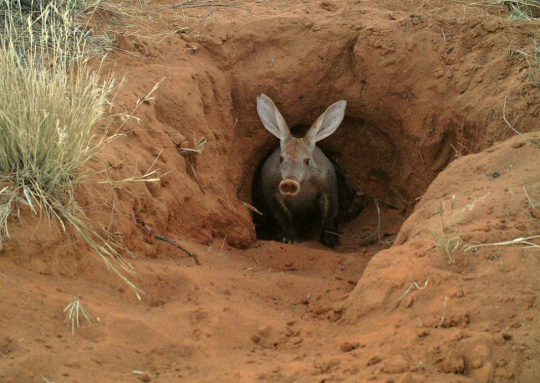By John Wible

Upon encountering this unusual digging mammal, South African colonists dubbed it aardvark, which is Afrikaans for earth pig or groundhog. With an adult weight of 90 to 150 pounds they dwarf our Western Pennsylvanian groundhog and additionally look nothing like it! Aardvarks (Orycteropus afer) are solitary, nocturnal mammals, which means they live alone and are active almost exclusively at night. They have powerful forelimbs and very sharp, robust front claws perfect for digging large burrows and into the nests of their food prey: ants and termites. Their nostrils, which are vertical slits, can be closed completely and have a fringe of thick hairs that helps to keep soil out while they are rooting for food. They have poor eyesight but a phenomenally keen sense of smell. In fact, aardvarks have the highest number of olfactory turbinal bones of any mammal; these are the fine, scroll-like bones in the nasal cavity that are covered by olfactory epithelium for sense of smell. And given those long rabbit-like ears, they also have a keen sense of hearing. Yet, aardvarks are for the most part silent, using hearing to find prey and avoid predators and not to find each other.
Aardvarks were thought to be related to other myrmecophagous (ant-eating) mammals, namely the South American anteaters and Old World pangolins. However, analysis of their DNA groups aardvarks with other very different looking African mammals in a clade of unlikely bedfellows called Afrotheria, which includes elephants, hyraxes, sengis or elephant shrews, golden moles, and tenrecs, along with manatees and dugongs. Consequently, the dietary and digging adaptations of aardvarks have evolved independently of those in the South American anteaters and pangolins. The earliest aardvark fossils are from African and are roughly 20 million years old. They did expand into southern Europe and into Asia as far east as Pakistan, but today are confined to sub-Saharan Africa in habitats that provide ants, termites, and water. Thankfully, their conservation status is currently of a non-threatened status.
John Wible, PhD, is the curator of the Section of Mammals at Carnegie Museum of Natural History. John’s research is focused on the tree of life of mammals, understanding the evolutionary relationships between living and extinct taxa, and how the mammalian fauna on Earth got to be the way it is today. He uses his expertise on the anatomy of living mammals to reconstruct the lifeways of extinct mammals. John lives with his wife and two sons in a house full of cats and rabbits in Ross Township.
